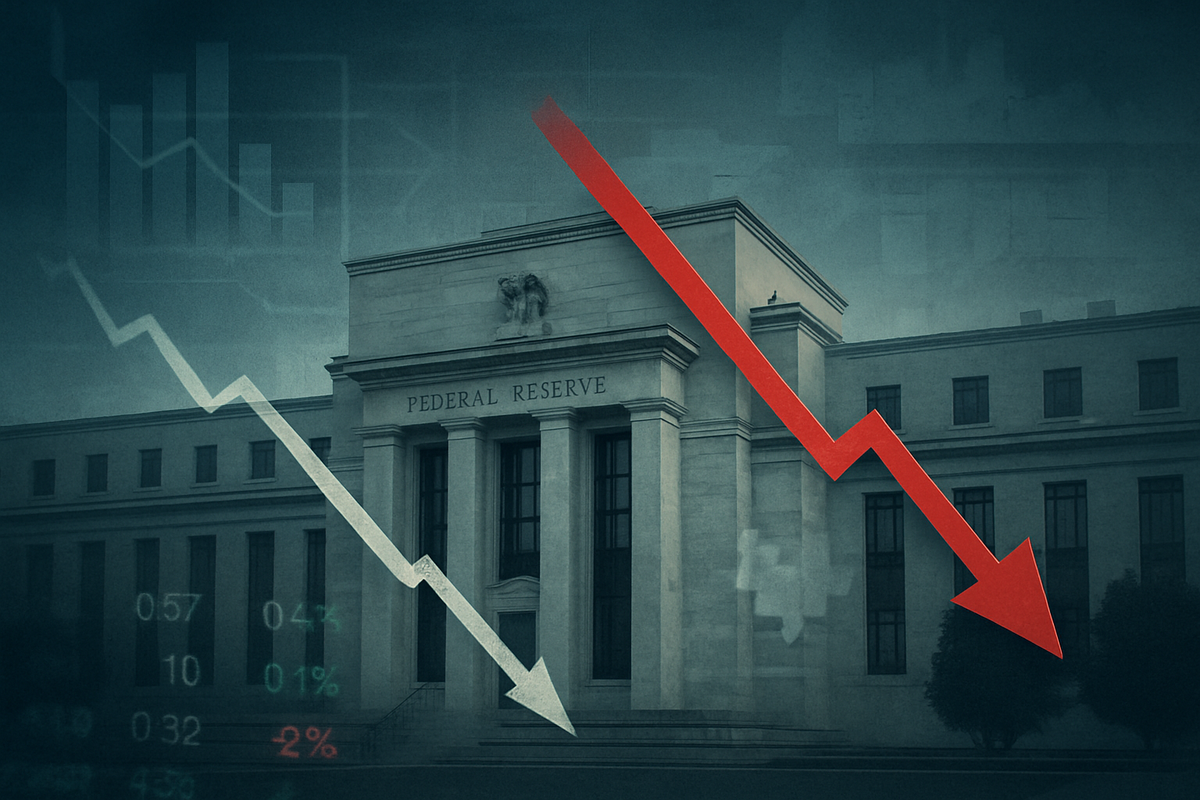
Federal Reserve Governor Stephen Miran has ignited a fervent debate within financial circles and the central bank itself, calling for swift and substantial interest rate cuts despite ongoing delays in crucial economic data caused by a government shutdown. As of October 3, 2025, Miran's assertive stance positions him as a leading voice for aggressive monetary easing, arguing that the current restrictive policy risks an unnecessary economic downturn. His perspective that delayed data should not deter immediate action sets a challenging tone for the Federal Open Market Committee's (FOMC) upcoming policy deliberations.
This bold advocacy for lower rates, even as other Fed officials express caution regarding inflation and data uncertainty, suggests a potential internal rift within the central bank. Miran's insistence on proactive cuts could significantly influence market expectations and force a re-evaluation of the Fed's strategy in navigating an economy grappling with both policy-induced data gaps and persistent inflation concerns. The implications for public companies and investment strategies are profound, as the prospect of rapid easing could reshape sector performance and corporate borrowing costs.
Miran's Unwavering Call for Lower Rates Amidst a Data Vacuum
Governor Stephen Miran's recent pronouncements, made in late September and early October 2025, have amplified calls for the Federal Reserve to dramatically recalibrate its monetary policy. Miran explicitly advocated for a half-percentage-point reduction in the federal funds rate, a more aggressive move than the recent quarter-point cut approved by the FOMC, from which he dissented. His core argument posits that the "neutral rate of interest" has significantly declined, rendering the current 4%-4.25% federal funds rate range "well into restrictive territory." This, he warns, risks "unnecessary layoffs and higher unemployment."
Miran attributes this perceived shift in the neutral rate to a confluence of factors. He points to the impact of President Trump's immigration and tariff policies, suggesting they influence population growth, housing prices, and overall inflation dynamics, while dismissing concerns that tariffs will lead to material inflation. Additionally, changes in fiscal and tax policies, coupled with a reduction in the federal budget deficit partly fueled by tariff revenues, are cited as factors easing upward pressure on interest rates. Other economic shifts, such as lower rental costs and deregulation, further contribute to his analysis of a lower neutral rate, with anticipated significant disinflation in the services component, particularly from shelter costs.
Crucially, Miran has downplayed concerns regarding the ongoing government shutdown's impact on economic data. While acknowledging the importance of "access to data," he argues that the Federal Reserve has ample time before its late October policy meeting to make informed decisions. He stressed that monetary policy should be "forward-looking," rather than overly reliant on "backward-looking indicators," which he deems "misguided." This perspective directly challenges the apprehension expressed by other Fed officials, such as Chicago Fed President Austan Goolsbee and Dallas Fed President Lorie Logan, who have voiced concerns about inflation and the challenges posed by data delays.
Miran's position also brings into focus the scrutiny surrounding the Federal Reserve's independence. As a recent appointee by President Trump and currently on leave from a White House advisory role, his aggressive calls for rate cuts align with President Trump's consistent demands for lower rates. Miran, however, steadfastly maintains that his economic analysis and policy recommendations are independently derived. His warnings of "longer-term risks" and potential "problems on your hands" if rates remain elevated underscore his belief that the Fed risks a significant policy error by not acting swiftly to avert a more severe economic downturn.
Market Reshaping: Winners and Losers in a Lower Rate Environment
The prospect of swift Federal Reserve interest rate cuts, as advocated by Governor Miran, promises to reshape the landscape for various public companies and sectors, creating distinct beneficiaries and those facing headwinds. As of October 3, 2025, with the Fed having initiated an easing cycle in September and market expectations high for further reductions, the implications for corporate balance sheets and consumer spending are substantial, even as delayed economic data due to the government shutdown introduces a layer of uncertainty.
Beneficiaries of Lower Rates:
- Real Estate and Homebuilders: This sector stands to gain significantly. Lower rates translate directly into reduced mortgage costs, boosting homeownership affordability and stimulating demand for both new and existing homes. Companies like D.R. Horton (NYSE: DHI), Lennar (NYSE: LEN), PulteGroup (NYSE: PHM), and Toll Brothers (NYSE: TOL) are poised for increased sales and potentially higher property values. Suppliers to the construction industry, such as Builders FirstSource (BLDR) and Mohawk Industries (MHK), would also benefit from a revitalized housing market. Mortgage Real Estate Investment Trusts (mREITs) like AGNC Investment (NASDAQ: AGNC) could see wider interest rate spreads due to lower borrowing costs.
- Consumer Discretionary: With lower interest payments on loans (credit cards, auto loans), consumers will have more disposable income, leading to increased spending on non-essential goods and services. This includes big-ticket items, benefiting retailers, and auto manufacturers such as General Motors Company (NYSE: GM). Mall REITs like Simon Property Group (NYSE: SPG) could also see increased shopper traffic and lower debt servicing costs.
- Technology (Growth Stocks): Growth-oriented technology companies, whose valuations often hinge on future earnings, benefit from lower discount rates, increasing their present value. Cheaper borrowing also fuels research, development, and expansion. While established giants like Alphabet (NASDAQ: GOOGL), Apple (NASDAQ: AAPL), Microsoft (NASDAQ: MSFT), and NVIDIA (NASDAQ: NVDA) have strong balance sheets, they also benefit from a "risk-on" market sentiment that favors growth. Companies with significant debt loads undergoing transformation, like Thryv Holdings, Inc. (NASDAQ: THRY), would see reduced interest expenses.
- Small-Cap Stocks & Capital-Intensive Businesses: Smaller companies, often more reliant on borrowed capital, benefit from reduced debt burdens, improving their ability to invest and expand. The Russell 2000 small-cap index has historically rallied in anticipation of rate cuts. Similarly, capital-intensive businesses like Caterpillar (NYSE: CAT) (construction equipment) and AT&T (NYSE: T) (telecommunications), with substantial debt, would see direct positive impacts from reduced interest payments.
Sectors Facing Headwinds:
- Traditional Financial Institutions: While the overall market might react positively, traditional banks often face challenges. Lower interest rates can compress net interest margins (NIMs)—the difference between interest earned on loans and interest paid on deposits—potentially impacting profitability if not offset by increased lending volume.
- "Bond-Proxy" Industries: Sectors like Utilities and Consumer Staples, typically favored for their stable dividends, may become less attractive. As bond yields decline with interest rates, the yield premium offered by these stocks narrows, making higher-growth cyclical stocks more appealing in a "risk-on" environment. Utility companies such as NextEra Energy (NYSE: NEE), Duke Energy (NYSE: DUK), American Water Works (NYSE: AWK), and Constellation Energy (NASDAQ: CEG), while benefiting from lower borrowing costs, might see their stock appeal diminish relative to other investments.
The ongoing government shutdown, which began on October 1, 2025, has further complicated this outlook by delaying crucial economic data. This "flying blind" scenario for the Fed introduces substantial uncertainty. Should the economic slowdown prove more severe, consumer caution could mute the positive effects of lower rates, especially in discretionary sectors. A divergence between aggressive market expectations and a more hesitant Fed due to data vacuum and persistent inflation could also lead to significant market volatility, impacting performance across all sectors.
Broader Implications: Navigating a Data-Starved Policy Landscape
Governor Miran's impassioned plea for aggressive interest rate cuts, delivered against the backdrop of an ongoing government shutdown and the resulting delay in vital economic data, carries profound wider significance for financial markets, industry trends, and the very independence of the Federal Reserve. As of October 3, 2025, this scenario underscores the complex challenges of data-dependent policymaking in an information vacuum and highlights potential internal disagreements within the central bank.
Broader Industry Trends and Ripple Effects:
A swift rate-cutting cycle, if adopted by the Fed, would likely make borrowing cheaper, increasing liquidity and encouraging spending and investment. This typically fosters a "risk-on" shift in investor sentiment, often benefiting growth stocks, particularly in the technology sector, as lower discount rates boost their future earnings' present value. The housing market would likely see increased affordability and demand due to lower mortgage payments. Conversely, traditional banking could face squeezed net interest margins, while "bond-proxy" industries like utilities might lose some appeal as bond yields decline.
The Federal Reserve's actions, especially concerning interest rates, also have significant global spillover effects. Lower U.S. rates generally weaken the U.S. dollar, benefiting Eurozone importers and consumers. Emerging markets (EMs) often emerge as primary beneficiaries, as a weaker dollar eases the burden of dollar-denominated debt and attracts capital flows seeking higher yields. This could lead to parallel rate cuts by many EM central banks and boost EM equities and bond markets, while making U.S. exports more competitive internationally.
Regulatory and Policy Implications:
Miran's public dissent and call for aggressive cuts, particularly from a politically appointed Governor (and one on leave from a White House advisory role), could intensify scrutiny over the Fed's independence. This might invite increased political pressure or calls for greater oversight, potentially challenging the central bank's traditional autonomy.
Furthermore, the data blackout caused by the government shutdown necessitates a greater reliance on private-sector indicators and alternative data sources. This situation could prompt a re-evaluation of data collection and dissemination protocols during future government shutdowns, emphasizing the need for robust contingency plans. The current environment also underscores the ongoing debate within the Fed regarding its Quantitative Tightening (QT) program, and when to slow or halt it to avoid bond market instability.
Historical Precedents and Comparisons:
Historically, the Federal Reserve has navigated periods of economic uncertainty and data limitations, often resorting to proactive policy responses. The concept of "insurance cuts" has been evident in the past, where the Fed implemented rapid rate reductions to prevent perceived negative outcomes, even with limited real-time data. Notable examples include the 1998 Long-Term Capital Management crisis and the early response to the pandemic, where rates were slashed based on preliminary indicators.
Government shutdowns have consistently led to delayed economic data, complicating Fed decision-making. While short shutdowns usually have minimal long-term macroeconomic impact, extended delays add significant uncertainty. In such cases, the Fed typically relies on available information and its assessment of underlying economic momentum. Dissenting voices within the FOMC are not unprecedented, but frequent or widespread dissents can signal internal division and potentially lead to market volatility and concerns about policy predictability, as seen in instances in 1988 and 1993. The current scenario highlights the delicate balance between data dependency, proactive risk management, and maintaining the central bank's independence in politically charged environments.
The Road Ahead: Navigating Policy Crossroads and Market Volatility
The Federal Reserve stands at a critical juncture as of October 3, 2025, facing the complex decision of whether to heed Governor Miran's call for swift interest rate cuts or to maintain a more cautious stance amidst a weakening labor market, persistent inflation, and the unprecedented challenge of delayed economic data due to a government shutdown. The path chosen will define the economic trajectory and market dynamics for the foreseeable future.
Scenario 1: Swift Interest Rate Cuts (as urged by Miran)
Should the Fed adopt an aggressive easing strategy, potentially involving larger cuts or a faster sequence than currently anticipated, it would signal a strong conviction that preventing a deeper economic downturn, particularly in the labor market, outweighs immediate inflation concerns.
- Short-Term Possibilities: Markets would likely see an immediate rally in equities and bonds, driven by optimism for cheaper borrowing and increased liquidity. Interest-rate-sensitive sectors such as technology, housing, and consumer discretionary would experience a boost. The absence of official government data might even empower this camp, allowing for preemptive action based on private-sector indicators.
- Long-Term Possibilities: If successful, this could lead to a "soft landing," where the economy gradually decelerates, inflation returns to target, and growth remains mild. However, the primary challenge is the risk of re-igniting inflation, which is already above target. Aggressive cuts could unanchor inflation expectations, potentially forcing the Fed to reverse course later, leading to a "hard landing" or even stagflation.
- Strategic Pivots: The Fed would explicitly prioritize employment stability, potentially accepting a longer timeline for inflation to return to its 2% target. It might also signal greater flexibility in its monetary policy framework and adjust its Quantitative Tightening (QT) program to inject further liquidity.
Scenario 2: Cautious Stance (Delayed due to Government Shutdown Data)
Alternatively, if the Fed proceeds with greater deliberation, delaying further cuts or implementing them at a slower pace, it would reflect deep concerns about persistent inflation and the uncertainty from missing economic data. Dallas Fed President Lorie Logan's warnings against easing too much and risking a reversal underscore this approach.
- Short-Term Possibilities: Initial market reactions could be negative, with potential pullbacks in equities if expected cuts are delayed. This could lead to increased volatility. A cautious stance would prolong tighter financial conditions, potentially leading to a more pronounced economic slowdown and continued elevated borrowing costs for businesses and consumers.
- Long-Term Possibilities: A successful cautious strategy could lead to a more sustainable reduction in inflation, albeit with a potentially slower economic recovery. It prioritizes long-term price stability. However, the risk of a deeper economic downturn or a "hard landing" increases if the Fed waits too long to ease policy, especially if the labor market continues to deteriorate significantly.
- Strategic Pivots: The Fed would reinforce its data-dependent approach, emphasizing flexibility and patience. They would prioritize monitoring evolving economic conditions, using a wider array of private-sector data to supplement delayed official statistics, and carefully balancing the dual mandate with a strong emphasis on ensuring inflation is firmly on a path to 2%.
Market Opportunities and Challenges:
- Opportunities: Swift cuts favor growth stocks, technology, small-caps, cyclical sectors (housing, consumer discretionary), and longer-duration bonds. A cautious stance might benefit value stocks, dividend payers, healthcare, utilities, and shorter-duration bonds. Gold could perform well in either scenario, acting as a safe haven or benefiting from rate cut hopes.
- Challenges: Swift cuts risk re-igniting inflation and creating asset bubbles, while potentially squeezing bank margins. A cautious stance risks a deeper recession, increased market volatility and investor uncertainty, and underperformance of growth-oriented, highly leveraged companies. The government shutdown exacerbates all these challenges by obscuring the true state of the economy.
Likely Scenarios and Outcomes:
Given the conflicting signals of a weakening labor market and persistent inflation, coupled with the data limitations from the government shutdown, the most likely immediate scenario involves the Fed making further, albeit cautious, rate cuts. Market expectations lean towards another 25 bps cut in October and potentially a third by year-end, bringing the federal funds rate to a range of 3.5%-4.0%. This "dovish cut" acknowledges economic weakness while maintaining a watchful eye on inflation.
The trajectory beyond year-end 2025 will hinge on whether inflation convincingly heads towards 2% and if the labor market stabilizes without a hard landing. If inflation remains sticky, the "higher for longer" narrative for long-term rates could persist, even with short-term cuts. The Fed will likely continue a gradual easing cycle, carefully balancing its mandates. The long-term outcome could range from a successful "soft landing" to a more challenging environment if inflation proves more entrenched or a deeper recession materializes.
Conclusion: A Balancing Act in Uncharted Waters
Governor Miran's forceful advocacy for swift Federal Reserve interest rate cuts, even in the face of delayed economic data due to a government shutdown, marks a critical moment for U.S. monetary policy. As of October 3, 2025, the central bank is navigating a complex landscape defined by a softening labor market, persistent inflation, and an unprecedented data vacuum. Miran's argument for proactive easing highlights a significant internal debate within the Fed, challenging the more cautious approach favored by many of his colleagues.
The implications for the market are substantial. A path of aggressive cuts could unleash a "risk-on" rally, particularly benefiting growth stocks, the housing market, and consumer discretionary sectors, while potentially pressuring financial institutions. Conversely, a cautious, data-dependent stance, while aiming for long-term price stability, risks a deeper economic slowdown and heightened market volatility. The ongoing government shutdown only magnifies this uncertainty, forcing the Fed to make critical decisions with incomplete information.
Investors should closely watch the Federal Reserve's communications and any emerging economic data (official or private-sector) in the coming months. The October FOMC meeting will be particularly telling, revealing whether Miran's persuasive arguments gain broader traction or if the Fed maintains its measured approach. The balance between stimulating growth and controlling inflation, complicated by political and data-related challenges, will determine the market's trajectory and the economy's health in the near and long term. The current environment demands vigilance and adaptability from all market participants.
This content is intended for informational purposes only and is not financial advice






